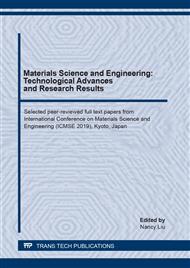[1]
Dizon, J.R.C., Espera, A.H., Chen, Q., Advincula, R.C. Mechanical characterization of 3-D printed polymers. (2018).
Google Scholar
[2]
Xu, R.L., Leguillion, D. Dual Notch Void Model to Explain the Anisotropic Strengths of 3D Printed Polymers. Submitted to Journal of Engineering Materials and Technology (2019).
DOI: 10.1115/1.4044282
Google Scholar
[3]
Tranchard, S., Rojas, V., Manufacturing our 3D Printed Future. (2015).
Google Scholar
[4]
Arivazhagan, A., Masoo, S.H. (2012) Mechanical Properties of ABS Material Processed b Fused Deposition Modelling: submitted to International Journal of Engineering Research Application. (2012).
Google Scholar
[5]
Klein, P.W. Fundamentals of Plastic Thermoforming. Morgan and Claypool. (2009).
Google Scholar
[6]
Caulfield, B., McHugh, P.E., Lohfeld, S. Dependence of mechanical properties of polyamide Components on build parameters in the SLS process. J.Mater. Process Technology. (2007).
DOI: 10.1016/j.jmatprotec.2006.09.007
Google Scholar
[7]
L.D. Tijing, J.R.C. Dizon, I. Ibrahim, H.Y. Shon, A.N. Nisay, R.C. Advincula, 3D printing for membrane separation, desalination and water treatment. Applied Materials Today (in press), https://doi.org/10.1016/j.apmt.2019.100486.
DOI: 10.1016/j.apmt.2019.100486
Google Scholar
[8]
A.D. Valino, J.R.C. Dizon, A.H. Espera Jr, Q. Chen, J. Messman, R.C. Advincula, Advances in 3D Printing of Thermoplastic Polymer Composites and Nanocomposites, Progress in Polymer Science, 101162.
DOI: 10.1016/j.progpolymsci.2019.101162
Google Scholar
[9]
J.R.C. Dizon, Q. Chen, A.D. Valino, R.C. Advincula, Thermo-mechanical and swelling properties of three-dimensional-printed poly (ethylene glycol) diacrylate/silica nanocomposites. MRS Communications. 9, 209-217 (2019).
DOI: 10.1557/mrc.2018.188
Google Scholar
[10]
J.R.C. Dizon, A.D. Valino, L.R. Souza, A.H. Espera, Jr., Q.Chen, R.C. Advincula, Three Dimensional-Printed Molds and Materials for Injection Molding and Rapid Tooling Applications, MRS Communications, Vol Communications, Vol. 9, 2019, p.1267 – 1283, https://doi.org/10.1557/mrc.2019.147.
DOI: 10.1557/mrc.2019.147
Google Scholar
[11]
A.H. Espera, J.R.C. Dizon, Q. Chen, and R.C. Advincula, 3D-printing and advanced manufacturing for electronics. Progress in Additive Manufacturing. https://doi.org/1007/ s40964-019-00077-7.
DOI: 10.1007/s40964-019-00077-7
Google Scholar
[12]
Al C. De Leon, Qiyi Chen, Napolabel B. Palaganas, Jerome O. Palaganas, Jill Z. Manapat, Rigoberto C. Advincula, Highperformance polymer nanocomposites for additive manufacturing applications, React. Funct. Polym. 103 (2016) 141–155.
DOI: 10.1016/j.reactfunctpolym.2016.04.010
Google Scholar
[13]
Henke, K., Treml, S. Wood based bulk material in 3D printing processes for application in construction (2013).
Google Scholar
[14]
Ivanova, O., William C., Campbell, T. Additive Manufacturing and Nanotechnology: promises and challenges (2013).
Google Scholar
[15]
Stansbury, J., Idacavage, M. 3D printing with polymers: challenges among expanding options and opportunities. Dent. Mater. (2016).
DOI: 10.1016/j.dental.2015.09.018
Google Scholar
[16]
Ahn. S., Montero, M., Odell, D., Roundy, S., Wright, P.K., Anisotropic material properties of fused deposition modelling ABS. Rapid Prototyping. (2002).
DOI: 10.1108/13552540210441166
Google Scholar
[17]
Stark, M. Improving and Understanding Inter-filament Bonding in 3D – printed polymers. University of Tennessee, Knoxville. (2016).
Google Scholar
[18]
Alafaghani, A., Qattawi, A., Alrawi, B., Guzman, A. Experimental Optimization of Fused Deposition Modelling Processing Parameters: A Design for Manufacturing Approach. (2017).
DOI: 10.1016/j.promfg.2017.07.079
Google Scholar
[19]
Bellini, A., Guceri, S. Mechanical characterization of parts fabricated using fused deposition modeling. Rapid Prototyping. (2003).
DOI: 10.1108/13552540310489631
Google Scholar
[20]
Wagari, A., Lemu, H., Influence of 3D Printing FDM Process Parameters on Tensile Property of ULTEM 9085. University of Stavanger. (2018).
DOI: 10.1016/j.promfg.2019.02.047
Google Scholar
[21]
Christiyan, K.J., Chandrasekhar, U., Venkateswarlu, K. A study on the influence of process parameters on the mechanical properties of 3D printed ABS composite. (2016).
DOI: 10.1088/1757-899x/114/1/012109
Google Scholar
[22]
Chacon, J.M., Caminero, M.A., Garcia – Plaza, E., Nunez, P.J., Additive manufacturing of PLA structures using fused deposition modelling: Effect of process parameters on mechanical properties and their optimal selection.
DOI: 10.1016/j.matdes.2017.03.065
Google Scholar
[23]
Durgun, I., Ertan, I., Experimental investigation of FDM process for improvement of mechanical properties and production cost. (2014).
DOI: 10.1108/rpj-10-2012-0091
Google Scholar
[24]
Wu, W., Geng, P. Li, G., Zhao, D., Zhang, H., Zhao, J. Influence of layer thickness and raster angle on the mechanical properties of 3D – printed PEEK and a comparative mechanical study between PEEK and ABS.
DOI: 10.3390/ma8095271
Google Scholar
[25]
Ford SLN. Additive Manufacturing Technology: Potential Implications for US Manufacturing Competitiveness (2014).
Google Scholar
[26]
Liacouras, P., Garnes, J., Roman, N. Designing and Manufacturing an auricular prosthesis using computed tomography, 3-dimensional photographic imaging, and additive manufacturing: a clinical report. J ProsthetDent. (2011).
DOI: 10.1016/s0022-3913(11)60002-4
Google Scholar
[27]
Eckelman CA, Gardner DJ., Neivandt, DJ. Surface treatments of wood – plastic composites (WPCS) to improve adhesion. J Adhes Sci Technol. (2006).
DOI: 10.1163/156856106779116623
Google Scholar
[28]
Kinloch, A.J., Lau, C.C., Williams, J.G. The peeling of flexible laminates. International Journal of Fracture. (1994).
Google Scholar
[29]
Castagnetti, D., Dragoni, E., Spaggiari., A. Failure analysis of bonded T-peel joints: Efficient modelling by standard finite elements with experimental validation (2009).
DOI: 10.1016/j.ijadhadh.2009.10.004
Google Scholar
[30]
Butt, J., Mebrahtu, H., Shirvani, H. Peel and tensile test investigation of aluminum 1050 foil parts made with a new additive manufacturing process. (2015).
DOI: 10.1504/ijrapidm.2015.073550
Google Scholar


